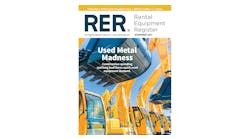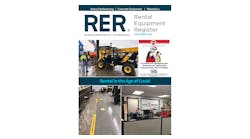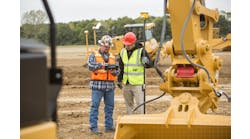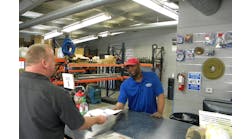Competing in the aerial rental business requires a high level of dedication to the segment because of the knowledge, training and risk involved. Add height to an application and it tends to make everyone a little nervous and for good reason: In 2004, the Bureau of Labor Statistics reported that 1,224 construction workers died on the job, with 36 percent of those fatalities resulting from falls.
Falls can result from a number of factors, including unstable working surfaces, improper use of protection equipment and operator error. According to the Occupational Safety & Health Administration, studies have shown that the use of guardrails, fall arrest systems, safety nets, covers, and travel restriction systems can prevent many of the deaths and injuries that result from falls.
Aerial work platforms are job specific. They aren't used by aerial work platform operators; they are used by electricians or welders or contractors erecting steel. They're used for putting up siding or installing surveillance cameras, for putting in sprinklers and acoustical tiles, and countless other kinds of jobs. Aerial equipment is a tool, and rental companies need to ensure their customers rent the right tool for the job.
Having the right equipment when and where the customer needs it is the trick to taking care of the rental customer. Larry Workman, president of Lemont, Ill.-based Illini Hi-Reach, likens the aerial rental fleet to the animals on Noah's ark: Aerial experts need every species of access equipment to cover their bases.
“Part of the problem with an aerial rental fleet is you have to be the main source for the contractor draw on any size of machine,” he says. “You have to have a supply, which means you've got to have a lot that you may not rent all the time, which means you may have more machines than you ever thought you would. But you have to have them so they're available. The minute that you don't, the customer that rented from you nine times out of 10 could leave you because you don't have what he needed.”
The proper equipment allows the best and safest equipment to be matched to the application. Howard Kaplan, vice president product market development for McConnellsburg, Pa.-based JLG Industries, says that the core of an aerial fleet is 40- and 60-foot booms, and electric scissorlifts. Beyond that, there are different sizes, configurations and power sources. To be considered an aerial specialist, a rental company would not only need the basic equipment, but a quantity of each piece, depending on the market size the company is trying to cover.
“You need to have 80-foot booms for certain applications because a lot of your contractors and a lot of your customers have different needs as a job progresses,” Kaplan says. “They start out needing 60-foots for 6 months, and they might need an 80 for 2 months. It's the same contractor as he gets to different stages. So if you're a specialist and you're going to provide all his needs, you need to have the full gamut of products.”
One product that is now a necessity for an aerial fleet is the telehandler. The telehandler is typically one of the first pieces of equipment on the jobsite because it's used to unload building materials and move them from one location on the site to another. Telehandlers can also lift materials to higher levels to place them where they need to be on a site. Bill Hindman, CEO of Industrial Marketing Services, Des Plaines, Ill., represents JLG and has more than 20 years in the industry. He says telehandlers and other aerial equipment work in tandem: Telehandlers lift materials, booms lift people. “People are finding a lot more applications for them,” Hindman says.
Workman has also seen increased demand for the telehandler in the past few years and says it's a good match for the aerial rental market. “It's a longer term rental than you would think,” he says. “It's usually one of the first machines on a job and one of the last to leave.”
Aerial rental specialists need to know their markets, as do those general rental companies that might be looking to add high-reach equipment to their fleets. Because aerial markets differ from city to city — Rapid City, S.D., for example, is quite different than Boston — Kaplan recommends looking at how vibrant the construction market is, what construction is going on, and how much competition is in the area. Then Kaplan suggests to decide whether to compete directly with existing companies or carve out a niche.
“With aerial work platforms, that's the great thing: You don't have to go and do what everyone else is doing. You can carve out a niche because there's a lot of parts of the business that are underserved,” he says.
Workman says that to compete in aerials, a company should shoot for about 10 to 15 percent of the market. But even that's not necessary if rental companies can find an underserved niche.
“Let's say you don't want to shoot for that 10 to 15 percent of your market to be a player in it. Find a niche. Find something that other people don't have in the aerial side,” says Workman. For Illini Hi-Reach, that meant jumping into the JLG 1350 SJP telescopic boomlifts early. “Nobody really had them, they were kind of new on the market, and we jumped into them real hard and real heavy, and we are now a really dominant player because we got in early,” he says.
Another important consideration is not to overpopulate the market with equipment. If there are 1,000 machines in a market, don't think that there's going to be a market for 2,000. “There's only certain lengths you can stretch the rubber band,” Workman says. “Our industry goes through cycles about every 10 years of having overpopulation in any market. You have to be conscious not to make an irrational choice and say, ‘I'm going to buy 250 machines,’ but that's 250 machines more than the market wanted or needed.”
The drop
Because the potential for serious injury for people in an elevated position is higher, all parties involved in an aerial transaction must practice the utmost responsibility. From loading and unloading to its actual use on the jobsite, the potential for injury is always present.
“I think the perception of it being a simple tool like driving a car — it goes up, it goes down, it goes left, it goes right — makes the industry a little bit more complacent on the higher level of risks that are attached to the tool,” says Aerial Work Platform Training's director of membership, Tony Groat.
While the rental company must familiarize the customer with the equipment and offer training upon delivery, it is impossible for a rental company to police who actually uses the equipment when they leave, an admitted gap in the system. In the salesman's rush to drop equipment off, and the contractor's rush to begin work, the familiarization process may be too brief — or not occur at all.
“I think that the inherent pressures of contractors needing to improve proficiency and profitability drive them to ‘let's get this done quick,’” says Groat. “The pressure of a rental company is to rent equipment and to be able to get it out and get it into the hands of customers. When you add those two together, the pressure to become fast and efficient and reduce cost — this puts training and familiarization at risk and as an industry, I think that we have not done what everyone knows to be required.”
At Illini Hi-Reach, the contractor signs off that they've been instructed on the safe operation of the machine. If no one's available to sign, which can be a frequent occurrence if contractors want equipment by sunrise, the company faxes the rental contract to the contractor's office. The contract is written to protect the company in the event of unauthorized use, and the machines are decaled letting operators know that third-party use is prohibited.
Roy Airington, president of Modesto, Calif.-based California High Reach, says it's difficult to police who uses the equipment because his employees start so early in the mornings — sometimes at 2 a.m. — to get equipment to customers bright and early. “The one good thing about this industry versus general rental is that you deal with the same customers over and over again, and a lot of times you have trained them,” Airington says.
Airington has language written into his company's contracts that protects him from liability in the case of unauthorized use, but says that in the instance of an accident, all parties get pulled into the investigation.
Hindman agrees. “Litigation is funny,” he says. “You can sue anybody. If I tripped on the sidewalk tomorrow, I could sue you. Everybody will try to sue a manufacturer because it's the deep pocket theory: You go after whoever's got the most money, and that's why the manufacturers are very stringent as far as their safety rules and manuals.”
Well-trained employees go a long way to ensure that rules and regulations are followed. Organizations such as International Powered Access Federation (IPAF) and its subsidiary AWPT exist to provide a forum for professionals to both listen and be heard about issues pertaining to the industry. Groat says that one of the fundamental services the AWPT offers is information. The organization aims to bring standardization and best practices to the industry.
“Whether it's the AWPT training program or some other training program, its primary objective is to raise the industry's standards and the understanding of those that are in the industry from operator to manufacturer to everyone in between to be aware of safe practices and how we can improve safety and efficiency for the industry,” Groat says.
AWPT has specific processes and procedures that must be adhered to in the delivery of training, including requirements for the trainers themselves. The AWPT requires those wanting to become trainers to have three years of experience.
“My concern for the industry is that if you wanted to go to a program to be a trainer, and you may know nothing, you could just go to someone's training program for a couple of days and now you can be a trainer,” Groat says. “Our belief is that that's not appropriate. We believe that training is a skill and you need to have someone with skills before we put them into a position of being an AWPT trainer.”
AWPT also has approved training centers, which have the obligation to ensure that the training facility meets the required criteria for an approved training site. Groat gives the example of being outside with poor acoustics, with poor lighting, in the extreme temperature: It just isn't conducive to appropriate training.
“We look at all aspects of training in our program, and the training center controls all of the requirements we put in the training program,” Groat says. “They are also accountable for registering and documenting all of the necessary information for the training programs: Who's being trained, when are they being trained, what are they being trained on, who's the trainer? All of the information that is required in the list of responsibilities defined by ANSI.”
Illini Hi-Reach has four employees who are certified by JLG to hold instructional schools or seminars for customers, having attended JLG's Train the Trainer classes. JLG recently announced a comprehensive Spanish-language training program for the growing Spanish-speaking part of the construction workforce.
The investment of time for proper training is worth it when all of the benefits are taken into consideration. AWPT's Powered Access Licensed-Registration (PAL) card gives five years of certification and takes only six to eight hours of time to complete. One day's investment for a five-year certification seems like a worthwhile investment.
In this world of increasing technology, it shouldn't come as a surprise that even aerial training is heading to the Internet. Guy Ramsey, publisher for Lift and Access magazine and 30-year veteran of the aerial rental industry, says that online training, to some degree, addresses two of the road blocks of proper training: time and money. Online methods can be convenient and low cost, and if properly administered, they also have the potential to reach more people. The human interaction that is missing prevents students from asking questions about the material, and while students may choose the right answers on a multiple choice exam, they may not know exactly why the answer is right, or why others are wrong.
“While I'm not dismissing it as a viable tool that can be used, I'm always concerned that as a delivery tool it eliminates the human interaction that I think is always vital to good learning,” Groat says.
Adequate training is a necessity because the most dangerous machines aren't the boomlifts or scissorlifts. The dangerous machines are those that have complacent or untrained workers operating them.
“The most complicated piece of equipment can be used safely and the most simplistic piece of equipment can be used unsafely,” Groat says. “So to me it's not a function of the equipment, it's the function of training.”
Stellar service
While the right equipment is necessary, servicing the equipment and the customer is equally, if not more, important. Some rental companies are willing to do what it takes to make sure equipment is on the jobsite by 7 a.m., even if that means getting around at 2 a.m. to do it. Mike Rolls of Rolls Scaffolding and High Reach is a 30-year industry veteran. With three California locations — Ventura, Long Beach and Riverside — he knows the importance of proper customer service. “In terms of any rental business, it's all about customer service and customer satisfaction, that's the bottom line,” Rolls says. “They want customer service, so that's how you have to do it and make sure you're there to give it to them.”
All equipment should be properly serviced and maintained at the correct intervals according to the manufacturer's guidelines. Each manufacturer has a detailed list of what is required for frequent inspections, which have to take place every three months or 150 hours of use, and annual inspections, which have to be done within 13 months of the last annual inspection, according to Groat. How do you keep track of all the inspections? If equipment's out on rent for months at a time, how do rental companies keep track of maintenance and inspections and ensure they are performed? Rental companies need to document service and maintenance carefully, to ensure that not only is equipment in the best possible shape, but so that if an accident occurs on a jobsite, the company is documented as having been diligent with equipment inspections and maintenance.
The experts at St. Louis-based Midwest Aerials & Equipment take the aerial business and its dangers seriously. Their mission is to get man or material safely in the air, according to president Dan Tumminello. The company has built a base of experts who can service the equipment and deliver it, and apprentices are required to work with journeymen for several years before working on their own. Midwest treats customers as if their lives are on the line. As vice president Kevin Morrell says, “You can't die from a bad compressor. You can die from a bad 60-foot boom.”
Roy Airington says California High Reach has 43 mechanics to make sure that all maintenance is performed and documented. Each time a machine goes out, a service sheet is on it, whether it'll be out for an hour, a day or a week. Each service sheet is checked off by the mechanic who services it, signed by the mechanic, and signed by his supervisor. An additional quality assurance employee will check the service sheet after it's cleaned and before it goes out the following day.
Illini Hi-Reach has a similar inspection protocol. Workman says that each machine that goes out on rent has a contract with a checklist on the front for delivery and a checklist for pickup. This is done to ensure that the condition of the machine is the same upon pickup as it was on delivery. Upon the equipment's return, the service department inspects the equipment. Equipment that's not on rent is gone through periodically and tagged ready for rent or not ready for rent in the yard.
Aerial rental companies should consider how they will complete maintenance in circumstances when inspections are too involved to do on the jobsite. How will they complete an inspection if a mechanic goes to the jobsite and can't find the equipment in question? Is there language in the contract that makes it the users' obligation to make it available? What if equipment is shipped to another state during the winter months? How do you go about maintaining the equipment and its records?
“All of a sudden we have all of these obstacles and hurdles that complicate our ability to easily comply,” Groat says. “And all of a sudden it starts: ‘Ok, we'll do it most of the time.’ And the minute you cross the line, it becomes easier to cross the line the next time and the next time.”
JLG's Kaplan says that following the manufacturers' guidelines will ensure that maintenance is under control. He emphasizes the importance of a basic visual inspection. He says that often technicians will go to a jobsite to service a piece of equipment and will be back the next day fixing another problem. In the hurry to move on to the next jobsite, a technician can miss a problem that could have been spotted and fixed the first time. “Don't underestimate the benefit of a good visual inspection,” Kaplan says.
The bottom line is that these are responsibilities rental companies must accomplish and all team members must be willing to comply, and thorough documentation must occur. “If it's not documented, it didn't happen,” Groat says.
In case of emergency
“Safety is everything. It makes you or breaks you,” says Airington. But even companies that put safety as a top priority can still have accidents, and emergency procedures should be in place should an accident occur while operating aerial equipment. In case of an accident, Groat says to first attend to the personnel involved. Then ensure the safety of the site so that no one else is going to get hurt in trying to remedy the situation. A thorough accident investigation can prevent future problems.
Although safety devices can be a hassle and an inconvenience, aerial safety equipment should never be disabled. Overriding safety devices can allow equipment to continue to operate in dangerous situations. Ignoring safety precautions can also lead to problems, as happened in the case of a man who fell off one of Illini Hi-Reach's 60-foot booms.
“Unfortunately for him, I'm sorry that he fell, but he had the door propped open and he also wasn't tied off with a lanyard,” Workman says. “So everything he did possible to get himself hurt, he did.”
When the accident occurred, the company notified Illini. A decal by the controls and in the basket tells customers to immediately notify Illini in the even of an accident. Illini then notifies its insurance company and the manufacturer. The company then picks up the machine as quickly as possible and physically inspects the site. The machine is not rented again until any investigation is complete.
Ramsey says that in the event of an accident, the rental company should immediately send a competent employee to the jobsite to take as many pictures and ask as many questions as possible. A rental company should immediately notify its insurance carrier and then try to determine to the best of its ability what actually happened on the jobsite, documenting everything along the way.
“The machine is typically made to be the scapegoat, and it's up to the owner to make sure to stand up for the machine,” says Ramsey.
Aerial rental companies should also be aware of safe loading, unloading and transport issues of equipment. Groat says numerous accidents have occurred because of improperly loaded boomlifts. Bridges have been damaged and booms have gotten knocked off their bases because booms weren't loaded correctly. If this occurs on the highway, pieces of the equipment can hit cars behind the trailer. Airington also says he's heard of about seven machines in the last nine months that have hit bridges. One rental company recently hit a major freeway bridge in the Bay Area. “It smashed the trailer, took the boom right off. The only things that were left on the trailer were the wheels and the base of the machine. They had to retrofit the freeway, the overpass. It was God-forsaken ugly,” says Airington.
Airington also recommends parking on a firm, level surface when unloading and loading equipment. Add a little rain to a steep slope, and he says you're asking for it.
The unique aspects of aerial rentals challenge aerial rental companies to know the precise rules and regulations of the equipment and its use. Checking that renters and employees are both properly trained and certified, maintaining equipment and detailed documentation of issues involved with the machines can go a long way in ensuring that all bases are covered with aerial equipment. The more familiar aerial rental companies are with all aspects of aerials, the better off customers and employees will be, not just for their safety, but also for their satisfaction. Mike Rolls says that the specialization that is required of an aerial rental specialist helps them be more familiar and better trained with what they're doing. “Your user will get a better product and service just through that specialization,” he says.





